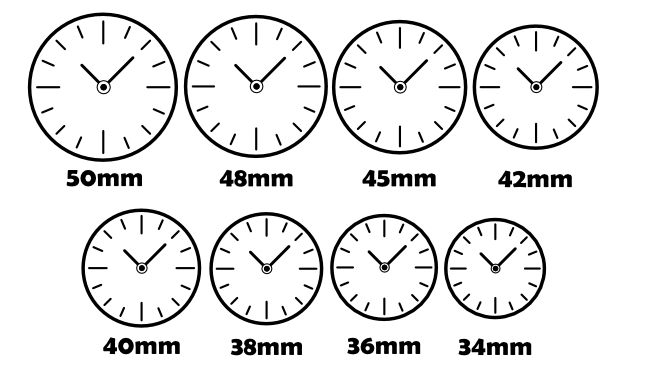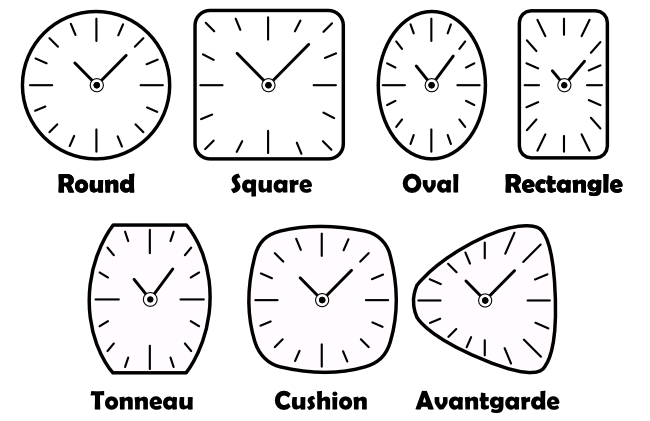Learn about the types of watch cases including the different sizes, shapes, and materials in this comprehensive guide to watch cases.
The case of a watch along with the strap determines how the watch feels on your wrist. If the case is too thick or big, it might hit on things and not fit under a cuff. If the watch is too small, the dial may be too hard to read.
Ultimately watch case size, shape and material play a fundamental roll in watch design. As with most things, there are standards that have developed over time, and then there are the outliers that are experimenting with new ideas and materials. The main points of review are size, shape and material and of course the crystal or glass that covers the dial.
Contents
Watch Case Sizes
The size of a watch case is one of the most important factors to consider when looking to purchase a watch. Most cases consist of a base shape, to which lugs protrude from the top and the bottom where the strap attaches. Watches without lugs are called lugless or puck style watches, and typically the strap mounts to the underside of the case in a recess.
How are Watch Sizes Measured?
Most cases are measured in Millimeters in width (without crown) height (from the end of the lugs) and depth (how tall the watch sits off your wrist).

What Watch Size is Right for Me?
One of the greatest determinants for sizing a watch is the size of the person’s wrist. Wrists are measured in circumference and mostly range from 5 to 8 inches. My wrist is 7.25” and I feel most comfortable with a 42mm to 45mm case. Typically, anything below 40mm starts to feel small, and when I get past 48mm, things start feel big. (Check out my post on the largest watches, for reference.)
Watch Case Shapes
There are five basic watch case shapes. Obviously, the two most prevalent are Round and Square, and, along with their cousins Oval and Rectangle, you have covered most of the watch market.
One of the nonstandard shapes that is often discussed is the tonneau shape, tonneau in French means “cask” or “barrel” and it often looks like a rounded rectangle. Another shape type that often comes up is the “pin cushion” case, which, as the name suggests is a slightly rounded or puffy square shape.
The outliers or avantgarde case shapes come in all sizes. One of the most famous I believe is Hamilton’s triangular Ventura line. More here from the Gear Patrol Website.

Watch Case Materials
Watch cases have been made from every material imaginable, but there is one material that truly stands out, stainless steel. When it comes to stainless steel, the one I see the most is 316 or A4, which is the second most common type and is often known as marine grade stainless steel. The distinguishing difference of 316 is the addition of molybdenum, which provides greater corrosion resistance than the standard 304/A2 grade.
Below is a quick list of watch case materials currently available on the market with their corresponding pros and cons.
Metals
Stainless Steel – High quality material, strong with great wear resistance and corrosion properties. Easy to work with and available at a reasonable price. The only real down sides for stainless is that it is often heavier than other metals that are available. The vast number of dive watches use 316 stainless steel.
Damascus Steel – Several watch brands are using Damascus Steel for there cases. Characterized by the watery flowing bands in the metal Damascus Steel is hard and incredibly beautiful. Today’s Damascus steel is either surface etched (fake) or pattern-welded by forging iron and steel together and hammering them together at high temperatures to weld the bond. The best example of this type of case is from the brand GOS.
Titanium – Titanium is an excellent choice for a watch case, especially tool or extreme use watches. Titanium is exceptionally light, hard and corrosion resistant making it perfect for dive watches. The only possible downside is the titanium has a dull gray look to it that some find less than appealing. Check out the SINN T1 for an example of an awesome titanium dive watch.
Tantalum –This rare highly inert and corrosion-resistant metal has a blue-gray luster and is sometimes used as a substitute for platinum. I have only seen one watch cased in this metal and it is still available on the Helson website if you are so inclined.
Aluminum – Aluminum is rarely used for watch cases as it does not have the strength of steel and can easily be dented. The benefits of aluminum are its light weight and excellent corrosion resistance. I really like my blue Hamilton Khaki Pilot Pioneer in Aluminum. It is super light and has a wonderful mat sheen, the feels very aerotactical.
Brass/Bronze and Aluminum Bronze – There has been several manufacturers on the market making copper-based watch cases for the last few years. The cases come in primarily three types, Brass, Bronze and Aluminum Bronze. Brass is typically made from 66% copper and 34% zinc. Bronze is an alloy that is made from copper with typically 8-13% tin with other trace metals and sometimes metalloids, it is often referred to as CuSn8 when discussing watch cases. Aluminum Bronze is copper with any where from 4-15% aluminum added, which results in a strong very corrosion-resistant alloy. The interesting thing with these copper-based cases is that over time thy create a patina. One of my favorite brands for copper-based watch cased watches is Maranez, they make solid watches at very reasonable prices. Check out their customer pictures page for some cool looking patinas. More here from Wound For Life.
Precious Metals – Of course you can get a watch case made with yellow, red or white gold or even platinum. There is no real advantage to casing a watch in a precious metal other than being able to say you spent a ridiculous amount of money for your watch. In fact, if the gold is too soft it will wear poorly and look aged before its time.
Non-Metal Cases
Case do not have to come in metal and there are plenty of examples of uniquely cases watches out there. Here are a few types that are becoming popular.
Wood – Wooden watch cases have been becoming more and more popular recently. I think it is part of the whole environmentally friendly movement/marketing programs. I have worn several and they tend to be exceptionally light and comfortable. My only problem with wood watches is they all have relatively cheap quartz movements and when the whole case is made of wood I always feel like I’m going to break them. There are some exceptions such as VEJRHOJ who mix wood and metal very effectively.
Ceramic – Clay based cases have been around for awhile starting when Rado launched the Diastar line in 1962. Omega has also been using ceramic materials in watch cases since the 70’s. Ceramic is a naturally hard material but is can be very brittle, thus making it difficult to work with for watch making. One of the unique sales points of the Rado was that it was scratch proof.
Sapphire – The Hublot MP-11 is entirely cased in Sapphire glass. I doubt the case would ever get scratched, but I would not want to risk knocking it around for fear of cracking it.
Carbon Fiber – A carbon fiber watch is basically a really tough plastic watch. Forged carbon fiber is particularly interesting and cool with the swirl pattern in the carbon taking front stage. One of my favorite carbon fiber watch is the Tempest Carbon (Edit: the tempestwatches.com website seems to be having issues right now, but you might be able to find them on Amazon).
Plastic – Plastic has become one of the most prevalent materials in watch making, especially at the low end of the market. That is not to say all plastic watches are cheap, there are several brands that use the material to excellent effect. A case in point is that of the brand Luminox, who make military inspired, heavy duty plastic cased watches with quality quartz movements equipped with excellent night visibility.
Glass Watch Cases
To cover and protect the dial of a watch it is covered with a transparent material. The material of choice is Sapphire Glass, which is made from synthetic sapphire and is very clear and hard. Other materials used to protect the dial include Acrylic Glass, Mineral Crystal Glass and of course plastic on low end watches. This is a great quick article from watchranker.com on glass types.

